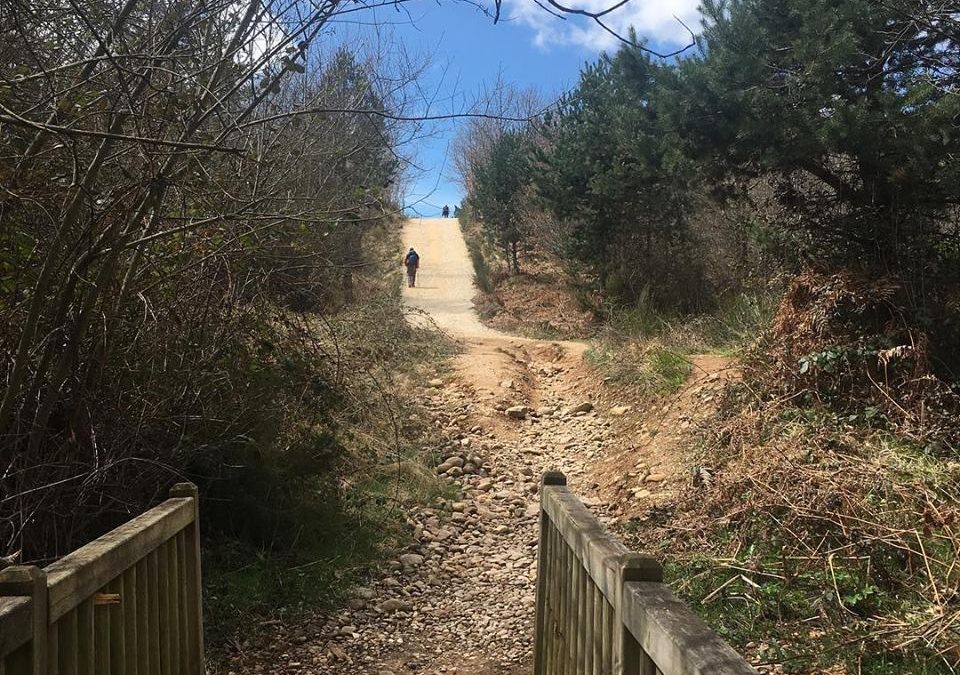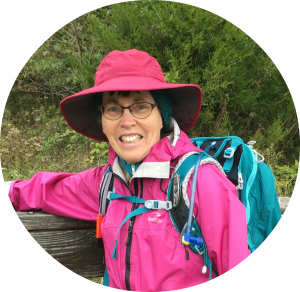
Small town girls take on the city
Day 13, April 17: San Juan de Ortega to Burgos (22 km, 13.5 miles on foot; @ 9 km, 5.6 miles by bus from outskirts of town)
It is Friday morning, April 19, as I begin this post, hoping to catch up on my Camino narrative. It will be short–I hear that sigh of relief at your end!–though later today I’ll attempt to post a few photos. Very few were taken on this day and few notes dictated as well. For one thing, I was still chilled from the frigid interior of the monastery in which we slept, plus the morning air was cool and damp so I had little interest in removing gloves and getting my phone out to take photos or record thoughts. And for another: it was a thick pea-soup of a morning, so, really, there was very little to see! We were not witnessing the distant fog but rather walking right through it for a good while.
Our first stop, for a bite of breakfast, was a short 3.6 km trek down the trail where we were tickled to find a bar/cafe called L’alchemiste (somehow related to Paulo Coehlo’s book of the same title. Unfortunately we did not get a clear answer about the relationship and whether Coehlo stayed in this town when doing his Camino or while writing his book about it. He did write a book, no? At home I watched a video he narrated about doing the Camino, but it’s a bit vague to me at the moment.). Anyway, this was one of those sweet stops, and memorable for us because we got to know Amapola (as in “Poppy”), the lady who ran this place with, I’m assuming, her husband.
I told Amapola how welcoming (lo acogedora) she had been and what a nice spot she had. “Oh,” she explained (in Spanish), “but you see, I’m a pilgrim, too. So I know how important it is to meet up with friendly faces and with kindness along the way.” She went on to tell me that she “needs” her annual Camino trek, that each year, in winter, she goes out for a couple of weeks on the Camino, returning, of course, to be of assistance to the pilgrims who begin to trickle through in late winter and then become a horde as spring turns into summer. Before we left, we got our pictures taken with her and she sent us off with tight hugs and “buen caminos.”
As we exited that town (it was Agés, population 60), we were a bit confused by signage. (The first confusion of the day, but, unfortunately, not the last.) We crossed a simple medieval stone bridge built by San Juan de Ortega (a disciple of Santo Domingo and also a great friend to pilgrims, so think year 1050 or so), and then we had a choice to make at an arrowless intersection of two sandy, gravel-coated pathways. To the left: we would head off into the fog-filled countryside–very appealing–and to the right: a low-traffic paved road. A couple of Spanish girls thought the only logical thing to do was to turn left. We got our guidebook out, and after studying it and listening to Ginny’s gut feelings, we headed to the paved road. I kept turning back to check on the Spanish girls who remained in place maybe 15 yards along the left path for the longest time before the fog blocked our view of them. (We later learned that they eventually retraced their steps and came out to the road behind us. The correct decision.)
Just before entering the village of Atapuerca (a whopping 200 inhabitants) we passed two spots of interest. One consisted of a bunch of stone memorial obelisks commemorating a battle–year 1054–in which two brothers, one king of the area known then as Castilla, the other king of neighboring Navarra, came to fisticuffs resulting in the death of one of them. (You probably realize that “Spain” was not always “Spain,” but a series of kingdoms. Ferdinand and Isabel–financiers of Christopher Columbus’s trip to the “Indies”–solidified the country with their union, each bringing into the marriage two large kingdoms.) I have a confession to make: in general I am not doing justice to the history through which I am walking. I have the remnants of my years of study, greatly blurred by time, but neither the time nor the energy nor the ability to try to absorb too much new. And while you would think that, at the slow pace at which we are moving, it would be possible to learn a lot and “really get it,” such is not the case. Nor is it the intention of this pilgrimage. A pity to let so much go by the wayside, but that is the way it has to be, at least for this pilgrim.
The second thing found on the outskirts of Atapuerca was a sign indicating a diversion to an archeological site some 3 km off the route. We were not lured, but curious. From the guidebook I have since learned that it is a UNESCO World Heritage site because the prehistoric caves we might have visited there are said to be the source of the “earliest human remains ever discovered in Europe.” The book goes on to say that yes, our ancestors were cannibals and that “the latest analysis points to human activity going back 1.2 million years, and counting.” Back in the summer of 1967 I had visited the “Cuevas de Altamira” (or was it “Altamirano”?); I’m wondering now if that is still a revered site….
Here are the other memorable things of our trek towards Burgos:
- The rather steep climb on the rockiest pathway you could ever imagine. (I’ll be posting some photos of it.) In case there was ever any doubt, it was obvious that “we weren’t in Kansas” anymore
- A memorable stop in another village. Latin American music playing. I started swaying and moving right away with the lively music. A different accent from the woman on the other side of the counter. She was Venezuelan. The family comes here for six months of the year to earn their living from the pilgrim trade. I’ll be posting photos of her children as they prepared our fresh-squeezed orange juice, along with a couple of photos of the pilgrim-styled decor. A pleasant break to our day.
- Oh, the sheep! A huge flock of them just adjacent to our pathway. Is it possible they all wore bells? It was a lovely melodious sound. A joy for this lover of sheep.
- As for the rest, you’ve heard about it in my post about the “angelitos”: missing the turn-off for the “river route” and making the long and lonely trek around the airport to the industrial outskirts of Burgos and the dreaded sign alerting us to the fact that we still had 10 kilometers, hard asphalt, awaiting us. And then the “miracles” began! Before long: the hiking part of our day was over and the healthcare portion began.

